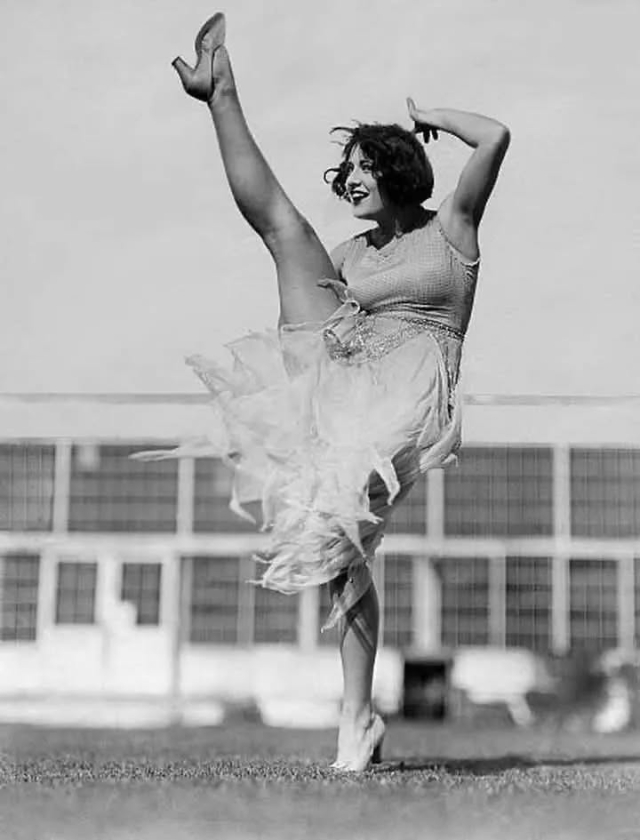“Joan Crawford is doubtless the best example of the flapper, the girl you see in smart night clubs, gowned to the apex of sophistication, toying iced glasses with a remote, faintly bitter expression, dancing deliciously, laughing a great deal, with wide, hurt eyes. Young things with a talent for living.” – F. Scott Fitzgerald
Many forget Joan Crawford March (born 23, 1906 – May 10, 1977) started out as a flapper in silent film roles. In fact, Crawford made a total of 29 silent movies throughout the late 1920s before successfully transitioning to talkies. She was one of the last flappers to emerge, when the archetype was already well established by other bigger stars like Clara Bow, Colleen Moore and Connie Talmadge.
Credited as Lucille LeSueur, her first film was Lady of the Night in 1925, as the body double for Norma Shearer, MGM’s most popular female star. She also appeared in The Circle and Pretty Ladies (both 1925), starring comedian ZaSu Pitts. This was soon followed by equally small and unbilled roles in two other 1925 silent films: The Only Thing, and The Merry Widow.
MGM publicity head Pete Smith recognized her ability to become a major star, but felt her name sounded fake; he told studio head Louis B. Mayer that her last name, LeSueur, reminded him of a sewer. Smith organized a contest called “Name the Star” in Movie Weekly to allow readers to select her new stage name. The initial choice was “Joan Arden,” but after another actress was found to have prior claim to that name, the alternative surname “Crawford” became the choice. She later said that she wanted her first name to be pronounced Jo-Anne, and that she hated the name Crawford because it sounded like “crawfish,” but also admitted she “liked the security” that went with the name.
Growing increasingly frustrated over the size and quality of the parts she was given, Crawford embarked on a campaign of self-promotion. As MGM screenwriter Frederica Sagor Maas recalled, “No one decided to make Joan Crawford a star. Joan Crawford became a star because Joan Crawford decided to become a star.” She began attending dances in the afternoons and evenings at hotels around Hollywood and at dance venues on the beach piers, where she often won dance competitions with her performances of the Charleston and the Black Bottom.
Her strategy worked and MGM cast her in the film where she first made an impression on audiences, Edmund Goulding’s Sally, Irene and Mary (1925). From the beginning of her career, Crawford considered Norma Shearer – the studio’s most-popular actress – her professional nemesis. Shearer was married to MGM Head of Production Irving Thalberg; hence, she had the first choice of scripts, and had more control than other stars in what films she would and would not make. Crawford was quoted to have said: “How can I compete with Norma? She sleeps with the boss!”
Crawford appeared as a skimpily clad young carnival assistant in The Unknown (1927), starring Lon Chaney, Sr. as a carnival knife thrower with no arms who hopes to marry her. She stated that she learned more about acting from watching Chaney work than from anyone else in her career. “It was then,” she said, “I became aware for the first time of the difference between standing in front of a camera, and acting.” Also in 1927, she appeared alongside her close friend, William Haines, in Spring Fever, which was the first of three movies the duo made together.
In 1928, Crawford starred opposite Ramón Novarro in Across to Singapore, but it was her role as Diana Medford in Our Dancing Daughters (1928) that catapulted her to stardom. The role established her as a symbol of modern 1920s-style femininity who rivaled Clara Bow, the original It girl, and Hollywood’s foremost flapper. A stream of hits followed Our Dancing Daughters, including two more flapper-themed movies, in which Crawford embodied for her legion of fans (many of whom were women) an idealized vision of the free-spirited, all-American girl.




























0 comments:
Post a Comment